Tuesday, August 22, 2006
Goshen College Maple Scholars stay busy with summer academic research and exploration
GOSHEN, Ind. – From art with old house paints to studying red blood cell membranes to researching Mennonite poetry, students have again been active this summer in independent research through the Goshen College’s Maple Scholars program.
Maple Scholars is an eight-week program that gives students the opportunity to participate in independent research alongside Goshen College faculty of various disciplines. Each scholar is paired with a faculty member who works with and supervises the individual to help carry out their work.
The 2006 Maple Scholars:
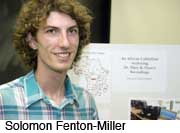 Solomon
Fenton-Miller (Sr., Marcellus,
Mich.), a music major, spent his summer cataloging traditional
African church music with Professor of Music Deb Brubaker and
Professor Emerita of Music Mary Oyer. This included editing and
copying Oyer’s large library of live recordings from cassette
tapes to CDs, as well as organizing handwritten data onto computer
files for future on-campus researchers.
Solomon
Fenton-Miller (Sr., Marcellus,
Mich.), a music major, spent his summer cataloging traditional
African church music with Professor of Music Deb Brubaker and
Professor Emerita of Music Mary Oyer. This included editing and
copying Oyer’s large library of live recordings from cassette
tapes to CDs, as well as organizing handwritten data onto computer
files for future on-campus researchers.
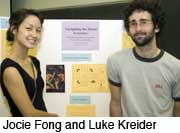 Jocie
Fong (Sr., Phoenix, Ariz.)
and Luke Kreider (Jr., Harrisonburg, Va.) looked into theories
of revenge, forgiveness and justice, and how people respond to
injustice and methods of vindication. They worked with Professor of
Bible, Religion and Philosophy Paul Keim and Associate Professor of
Peace, Justice and Conflict Studies Joe Liechty. Fong is a double
major with peace, justice and conflict studies and Spanish. Kreider
is a double major in peace, justice and conflict studies and Bible
and religion.
Jocie
Fong (Sr., Phoenix, Ariz.)
and Luke Kreider (Jr., Harrisonburg, Va.) looked into theories
of revenge, forgiveness and justice, and how people respond to
injustice and methods of vindication. They worked with Professor of
Bible, Religion and Philosophy Paul Keim and Associate Professor of
Peace, Justice and Conflict Studies Joe Liechty. Fong is a double
major with peace, justice and conflict studies and Spanish. Kreider
is a double major in peace, justice and conflict studies and Bible
and religion.
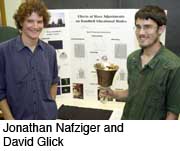 David
Glick (Jr., Goshen), a physics
major, and Jonathan Nafziger (Soph., Goshen), a physics and art double
major, worked with Professor of Physics John Ross Buschert
investigating the vibrations in handbells. They used computer
modeling of the vibrations – holographic interferometry
– as measurement, and tried several ways of modifying the
handbell to try to produce the best sound, from adding magnets, to
computer simulations of thinning the bell walls, which had positive
results. “It’s exciting, and gives confidence to
computer models,” said Glick.
David
Glick (Jr., Goshen), a physics
major, and Jonathan Nafziger (Soph., Goshen), a physics and art double
major, worked with Professor of Physics John Ross Buschert
investigating the vibrations in handbells. They used computer
modeling of the vibrations – holographic interferometry
– as measurement, and tried several ways of modifying the
handbell to try to produce the best sound, from adding magnets, to
computer simulations of thinning the bell walls, which had positive
results. “It’s exciting, and gives confidence to
computer models,” said Glick.
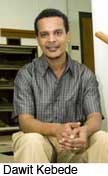 Dawit
Kebede (Sr., Ethiopia)
researched the correlation between ethnic peace and inter-ethnic
civic institutions, and then applied them to the history of
interactions between Christians and Muslims in Ethiopia.
Kebede’s faculty adviser was Associate Professor of History
Jan Bender Shetler. Kebede is a double major in peace, justice and
conflict studies and sociology/anthropology.
Dawit
Kebede (Sr., Ethiopia)
researched the correlation between ethnic peace and inter-ethnic
civic institutions, and then applied them to the history of
interactions between Christians and Muslims in Ethiopia.
Kebede’s faculty adviser was Associate Professor of History
Jan Bender Shetler. Kebede is a double major in peace, justice and
conflict studies and sociology/anthropology.
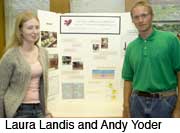 Laura
Landis (Sr., Orrville, Ohio)
and Andy Yoder (Soph., Sugarcreek, Ohio) spent their summer
with Professor of Biology James Miller looking at the effect of
phloretin on water and glycerol transport in avian erythrocytes, or
red blood cells. They tested avian species blood using a
spectrometer interfaced to a computer. Landis is a molecular
biology major and Yoder is a biology major.
Laura
Landis (Sr., Orrville, Ohio)
and Andy Yoder (Soph., Sugarcreek, Ohio) spent their summer
with Professor of Biology James Miller looking at the effect of
phloretin on water and glycerol transport in avian erythrocytes, or
red blood cells. They tested avian species blood using a
spectrometer interfaced to a computer. Landis is a molecular
biology major and Yoder is a biology major.
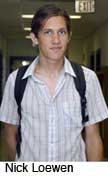 Nick
Loewen (Goshen), a 2006
graduate, explored various ideas about abstract painting with
limited resources, namely using old house paints and various
textured surfaces. “Limitations force the artist to be
resourceful, which is in itself a form of creativity,” Loewen
said. Loewen, an English and art double major, worked alongside
Professor of Art John Blosser.
Nick
Loewen (Goshen), a 2006
graduate, explored various ideas about abstract painting with
limited resources, namely using old house paints and various
textured surfaces. “Limitations force the artist to be
resourceful, which is in itself a form of creativity,” Loewen
said. Loewen, an English and art double major, worked alongside
Professor of Art John Blosser.
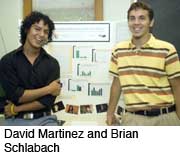 David
Martinez (Soph.,
Goshen) and Brian
Schlabach (Jr., West Liberty,
Ohio), both communication majors, looked into the news consumption
of local high school students, with additional focus on local
variables such as immigration and availability of the media. The
two filmed interviews with several students and made a brief
documentary based on their interviews and research. Associate
Professor of Communication Duane Stoltzfus advised their
work.
David
Martinez (Soph.,
Goshen) and Brian
Schlabach (Jr., West Liberty,
Ohio), both communication majors, looked into the news consumption
of local high school students, with additional focus on local
variables such as immigration and availability of the media. The
two filmed interviews with several students and made a brief
documentary based on their interviews and research. Associate
Professor of Communication Duane Stoltzfus advised their
work.
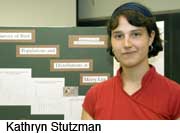 Jonathan
Mast (Soph., Millersburg,
Ohio) and Kathryn
Stutzman (Jr., Goshen) spent
their summer at Goshen College’s Merry Lea Environmental
Learning Center, exploring ornithology through a program called
Monitoring Avian Productivity and Survivorship, or MAPS. They
learned how to identify each bird caught, record data and band each
bird to study bird populations and distribution at Merry Lea. Mast
also investigated garlic mustard, an invasive species to North
America, and its effect on songbirds. They worked alongside Dave
Miller, Merry Lea’s program director and assistant professor
of biology, along with volunteer coordinator and environmental
educational instructor, Lisa Zinn. Mast is a physics major and
Stutzman is a biology major.
Jonathan
Mast (Soph., Millersburg,
Ohio) and Kathryn
Stutzman (Jr., Goshen) spent
their summer at Goshen College’s Merry Lea Environmental
Learning Center, exploring ornithology through a program called
Monitoring Avian Productivity and Survivorship, or MAPS. They
learned how to identify each bird caught, record data and band each
bird to study bird populations and distribution at Merry Lea. Mast
also investigated garlic mustard, an invasive species to North
America, and its effect on songbirds. They worked alongside Dave
Miller, Merry Lea’s program director and assistant professor
of biology, along with volunteer coordinator and environmental
educational instructor, Lisa Zinn. Mast is a physics major and
Stutzman is a biology major.
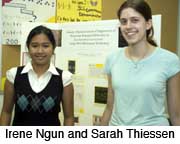 Irene
Ngun (Soph., Plano,
Texas) and Sarah
Thiessen (Sr., Austin, Texas)
researched with Professor of Biology Stan Grove searching for a
gene in a yeast genome that undergoes mutation in order to
transport potassium across a cell membrane. Using a microarray
technique, they combined a normal and a mutated yeast to look for
differences in each gene. “This technique can be used to look
for tumors, as genes act different ways for each type of
cancer,” said Thiessen. She is a molecular biology and
chemistry double major and Ngun is a molecular biology
major.
Irene
Ngun (Soph., Plano,
Texas) and Sarah
Thiessen (Sr., Austin, Texas)
researched with Professor of Biology Stan Grove searching for a
gene in a yeast genome that undergoes mutation in order to
transport potassium across a cell membrane. Using a microarray
technique, they combined a normal and a mutated yeast to look for
differences in each gene. “This technique can be used to look
for tumors, as genes act different ways for each type of
cancer,” said Thiessen. She is a molecular biology and
chemistry double major and Ngun is a molecular biology
major.
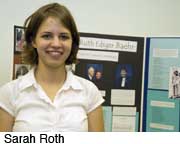 Sarah
Roth (Sr., Goshen) looked into
Mennonite poetry and what it means to be a Mennonite poet, as a
research assistant to Ann Hostetler, professor of English. She
focused particularly on Anna Ruth Ediger Baehr, a poet of the early
20th century who began writing when she was in her late
60s. Roth also organized and categorized Baehr’s papers and
journals in the Mennonite Church USA Archives building. Roth is a
history and English double major.
Sarah
Roth (Sr., Goshen) looked into
Mennonite poetry and what it means to be a Mennonite poet, as a
research assistant to Ann Hostetler, professor of English. She
focused particularly on Anna Ruth Ediger Baehr, a poet of the early
20th century who began writing when she was in her late
60s. Roth also organized and categorized Baehr’s papers and
journals in the Mennonite Church USA Archives building. Roth is a
history and English double major.
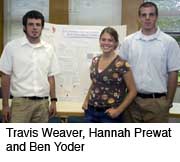 Travis
Weaver (Sr., Denver,
Pa.) and Ben
Yoder (Sr., Lancaster, Pa.)
spent their summer with Professor of Physics Carl Helrich,
researching the interaction between ion channels in cell membranes
and nystatin in cholesterol. They looked onto the fusion of
vesicles as a step in nerve transmission, which was marked by using
Monte Carlo computer simulations. “It’s another step in
trying to figure out how a cell works,” said Weaver. Weaver
and Yoder are both physics majors. They also worked with a faculty
member and student from Bethel College in Mishawaka, Ind. –
Erwin Sucipto, assistant professor of physics, and student Hannah
Prewat.
Travis
Weaver (Sr., Denver,
Pa.) and Ben
Yoder (Sr., Lancaster, Pa.)
spent their summer with Professor of Physics Carl Helrich,
researching the interaction between ion channels in cell membranes
and nystatin in cholesterol. They looked onto the fusion of
vesicles as a step in nerve transmission, which was marked by using
Monte Carlo computer simulations. “It’s another step in
trying to figure out how a cell works,” said Weaver. Weaver
and Yoder are both physics majors. They also worked with a faculty
member and student from Bethel College in Mishawaka, Ind. –
Erwin Sucipto, assistant professor of physics, and student Hannah
Prewat.
Maple Scholars was initially introduced in 1998 for students in the sciences – biology, chemistry, physics – but has expanded to include students doing research in other disciplines such as art, communication and environmental studies. For students interested in graduate school, the opportunities for longer-term research and potential publication is an excellent experience and résumé builder.
While many universities sponsor research projects, involving undergraduates in original research on a small liberal arts campus is unique and pays off for students seeking further education, as Goshen ranks in the top sixth among U.S. colleges for graduates who go on to earn doctoral degrees.
– By Megan Blank '07
Editors: For more information about this release, to arrange an interview or request a photo, contact Goshen College News Bureau Director Jodi H. Beyeler at (574) 535-7572 or jodihb@goshen.edu.
###
Goshen College, established in 1894, is a four-year residential Christian liberal arts college rooted in the Anabaptist-Mennonite tradition. The college’s Christ-centered core values – passionate learning, global citizenship, compassionate peacemaking and servant-leadership – prepare students as leaders for the church and world. Recognized for its unique Study-Service Term program, Goshen has earned citations of excellence in Barron’s Best Buys in Education, “Colleges of Distinction,” “Making a Difference College Guide” and U.S.News & World Report’s “America’s Best Colleges” edition, which named Goshen a “least debt college.” Visit www.goshen.edu.

 E-mail this story
E-mail this story